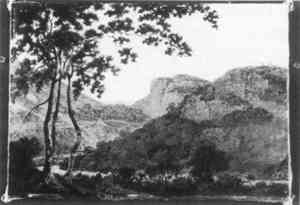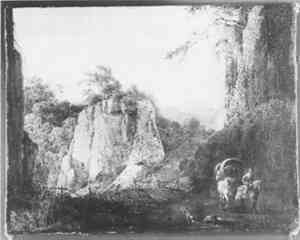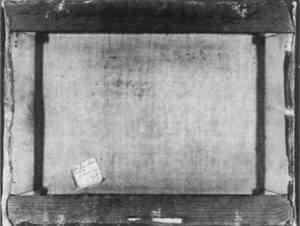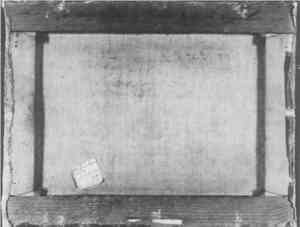AN 18TH-CENTURY ARTIST-APPLIED LINING: JOSEPH WRIGHT OF DERBY'S CUT THROUGH THE ROCK AT CROMFORD
IAN S. HODKINSON, & DEBORAH M. CHILD
1 INTRODUCTION
In 1988 the Agnes Etherington Art Centre of Queen's University at Kingston, Canada, acquired eight small paintings attributed to the British artist Joseph Wright of Derby (1734–97) (Nicolson 1968). Seven of the paintings are oil on canvas, while one is oil on paper. They are a fascinating group both art historically and technically since their conservation represents the whole gamut of degrees of later intervention, from nothing at all to complete treatment involving varnish removal, lining, retouching, and revarnishing. Wright left some notations about his working methods and materials, which made possible further interpretation of these works (Wright 18th c.).1 The group of paintings became the object of a combined art-historical and technical examination that resulted in many interesting observations (Brown 1990). The timing of the acquisition happily coincided with the mounting of the Tate Gallery's exhibition Wright of Derby and the publication of a comprehensive exhibition catalog (Egerton 1990) with an excellent technical section (Jones 1990).
Two of the paintings are of special interest to the conservator and to the study of historical painting techniques, because neither has been changed by later intervention and thus, except for the inevitable effects of age, they appear just as they did when they left the artist's studio. In addition, for the primary support of Cut through the Rock at Cromford, the evidence points to the fact that Wright apparently used a fragment of an old discarded painting by another hand, lined it, and used it for his own painting, leaving in the bottom right corner a group of figures from the earlier work visible as part of the composition of the finished painting. The two paintings concerned are Derwent Valley, Derbyshire(figs. 1, 2)2, and Cut through the Rock at Cromford(figs. 3, 4), hereafter referred to as Derwent and Cromford. Cromford, the lined painting, is the main focus of this study, but Derwent will also be described as it makes an interesting comparison with its unorthodox companion and complements other published studies on early untouched paintings by Wright of Derby and others (Wyld and Thomas 1986, Bomford 1979, Massing and Groen 1988).
Fig. 1.
Joseph Wright of Derby, Derwent Valley, Derbyshire (formerly titled River Valley, Derbyshire), oil on canvas 29.7 � 42.5 cm. Agnes Etherington Art Centre, Queen's University, purchased with the assistance of Dr. Alfred and Isabel Bader and the Government of Canada, 1988.
 |
Fig. 3.
Joseph Wright of Derby, Cut through the Rock at Cromford, oil on canvas, 45.5 � 59.0 cm. Agnes Etherington Art Centre, Queen's University, purchased with the assistance of Dr. Alfred and Isabel Bader and the Government of Canada, 1988. The staffage group at the bottom right corner is by another hand.
 |
Fig. 4.
Figure 3, reverse. Note the inventory label from the estate of John Holland.
 |
|



